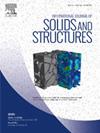Exploring the elliptic fissure cracking mechanisms from the perspective of sand 3D printing technology and Meshfree numerical strategy
IF 3.4
3区 工程技术
Q1 MECHANICS
International Journal of Solids and Structures
Pub Date : 2025-01-04
DOI:10.1016/j.ijsolstr.2025.113216
引用次数: 0
Abstract
The existences of cracks affect the strength and fracture morphologies of rock masses. However, there are few discussions on factors such as fissure apertures and quantities. Based on this background, sand 3D printing is used to prepare rock-like samples. Crack propagation experiments are carried out on fissured samples with different fissure apertures and fissure numbers. DIC technology is utilized to obtain the full-field strain distributions on specimen surfaces. Meanwhile, a meshless numerical method is developed to simulate rock damage evolutions. Results show that: Three crack types can be seen, wing cracks, shear cracks as well as main cracks. Wing crack extensions on two prefabricated fissures outer sides are along the loading direction, while inner side wing cracks overlap with two prefabricated fissures to form a “fusiformis-shaped part”. The propagation of shear cracks after wing cracks indicates final specimen failure. Main cracks exist in the circumstances with large fissure apertures. As fissure apertures increase, wing cracks initiating points deviate from tips, and the appearance of inner wing cracks in double fissure specimens precedes outer wing cracks. Stress–strain curves of the specimen experience five stages: 1) compressive stage; 2) elastic stage; 3) stress drop stage; 4) crack propagation stage and 5) failure stage. Finally, formation mechanisms of wing cracks, shear cracks, “fusiformis-shaped parts” as well as the mechanical influences of fissure apertures on the specimens are discussed.
求助全文
约1分钟内获得全文
求助全文
来源期刊
CiteScore
6.70
自引率
8.30%
发文量
405
审稿时长
70 days
期刊介绍:
The International Journal of Solids and Structures has as its objective the publication and dissemination of original research in Mechanics of Solids and Structures as a field of Applied Science and Engineering. It fosters thus the exchange of ideas among workers in different parts of the world and also among workers who emphasize different aspects of the foundations and applications of the field.
Standing as it does at the cross-roads of Materials Science, Life Sciences, Mathematics, Physics and Engineering Design, the Mechanics of Solids and Structures is experiencing considerable growth as a result of recent technological advances. The Journal, by providing an international medium of communication, is encouraging this growth and is encompassing all aspects of the field from the more classical problems of structural analysis to mechanics of solids continually interacting with other media and including fracture, flow, wave propagation, heat transfer, thermal effects in solids, optimum design methods, model analysis, structural topology and numerical techniques. Interest extends to both inorganic and organic solids and structures.

 求助内容:
求助内容: 应助结果提醒方式:
应助结果提醒方式:


